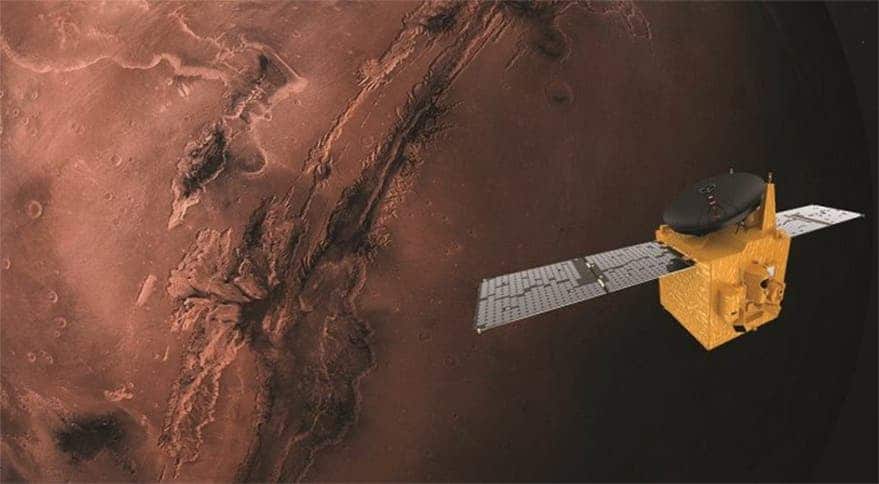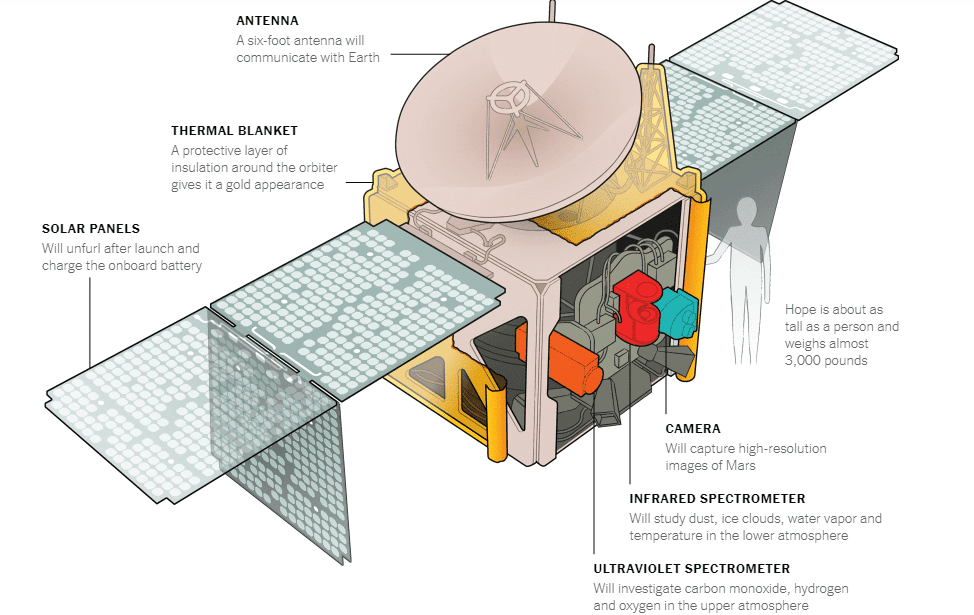The United Arab Emirates (UAE) doesn’t mess around when it comes to their space program — they’re taking big strides in their mission to launch a shuttle to Mars.

In July 2014, president Sheikh Khalifa bin Zayed Al Nahyan announced their plans to send a satellite to Mars by July 2020. This month, the Hope Mars Mission — also called the Emirates Mars Mission — is set to launch to the Red Planet this month for a February 2021 rendezvous. That year would also be the 50th anniversary of the country.
The launch comes just six years after not only the announcement of Hope but the creation of the UAE’s space program itself. That’s right, the Mohammed bin Rashid Space Centre, where the satellite was built, wasn’t created until the year after the announcement — and until then, the UAE had virtually no space program to speak of. America hasn’t seen that sort of haul-ass rush since the Apollo program.
The Hope mission will be the first major project spearheaded by the small Middle Eastern country. It’s actually the first planetary science mission to be led by an Arab-Islamic country, period. The satellite is set to launch from Tanegashima Space Center in Japan aboard an H-IIA rocket.
“The UAE is on the verge of making history, after turning its dream of becoming the first Arabic and Islamic country to send a spacecraft to Mars into reality,” said Ahmad Belhoul al Falasi, chairman of the United Arab Emirates Space Agency in a 2019 statement. “This monumental endeavor is the culmination of the efforts of a skilled and experienced team of young Emiratis, who, with the support of the nation and its visionary leadership, will secure the UAE’s position at the forefront of space exploration and the international space sector.”
The mini-cooper-sized probe was built in collaboration with the University of Colorado Boulder, University of California, Berkeley and Arizona State University. Its main mission will be to study Mars’ weather and climate. In particular, Hope has three main objectives:
- Understand climate dynamics and the global weather map through characterizing the lower atmosphere of Mars.
- Explain how the weather changes the escape of hydrogen and oxygen through correlating the lower atmosphere conditions with the upper atmosphere.
- Understand the structure and variability of hydrogen and oxygen in the upper atmosphere, as well as identifying why Mars is losing them into space.

The current status
The Emirates Mars Mission has a total mass (including fuel) of 1500 kg. It is a hexagonal prism, 7.78 feet (2.37 meters) wide by 9.5 feet (2.90 meters) tall. It consists of honeycomb aluminum panels containing composite face sheets, with three solar panel wings affixed to the top platform. The solar panels provide 600 watts at Mars, charging batteries to run the spacecraft. The spacecraft requirement is 477 watts. The shuttle’s high-gain directional antenna allows communication rates of 1.6 Mbps at the minimum Earth-Mars distance to 250 kbps at its furthest point. There are also three low-gain antennas.
Propulsion is provided by four to six 120-N thrusters mounted on the bottom of the spacecraft, using monopropellant hydrazine and a GHe pressurant tank, with maneuvering and attitude control via 8 to 12 5-N reaction control system thrusters and a set of reaction wheels. Positional and orientation knowledge is provided by star trackers and coarse Sun sensors.
The satellite will carry three scientific instruments mounted on one side of the spacecraft. The Emirates eXploration Imager (EXI) is a high resolution multiband (visible and UV) camera, the Emirates Mars Ultraviolet Spectrometer (EMUS), a far-UV imaging spectrograph, and the Emirates Mars InfraRed Spectrometer (EMIRS), and FTIR scanning spectrometer.
The plan
Once the Hope Probe separates from the upper stage, an automated sequence will begin to wake up the probe. The central computer will boot up and turn on the heaters to prevent the fuel from freezing. It will then deploy the solar array panels and use the sun sensors to find the sun so that the solar arrays begin to charge the onboard battery. With the power switched on, Hope will begin transmitting data back home to the NASA Deep Space Network ground station in Madrid, Spain.
After the communications system is checked out, the control system will ensure that the spacecraft is pointed in the right direction. The propulsion system onboard will ensure detailed maneuvers to refine the Hope Probe’s trajectory towards Mars.
Once it completes the seven-month journey and arrives at its objective, Hope begins the Mars Orbit Insertion phase. Nearly half of the fuel will be spent to slow the probe down enough to capture Mars’ orbit. The fuel burn (firing the Delta V thrusters) will last approximately 30 minutes and will reduce the speed of the spacecraft from over 75,186 mph (121,000 kmh) to around 11,184 mph (18,000 kmh).
Hope is now ready to start its mission, collecting two years worth of data, with an optional two-year extension which would take the mission into 2025.
“This is the Arab world’s version of President John F. Kennedy’s moonshot — it’s a vision for the future that can engage and excite a new generation of Emirati and Arab youth,” said Yousef al Otaiba, the UAE’s ambassador to the United States, during the UAE Embassy’s National Day celebration in 2015, according to The National.
But the UAE doesn’t plan on stopping there. By 2117, they hope to build a habitable settlement, a project that no one who starts on will ever see completed in their lifetime.
“We chose the epic challenge of reaching Mars because epic challenges inspire and motivate us,” Mohammed bin Rashid said 2014 when the Hope project was announced. “The moment we stop taking on such challenges is the moment we stop moving forward.”


